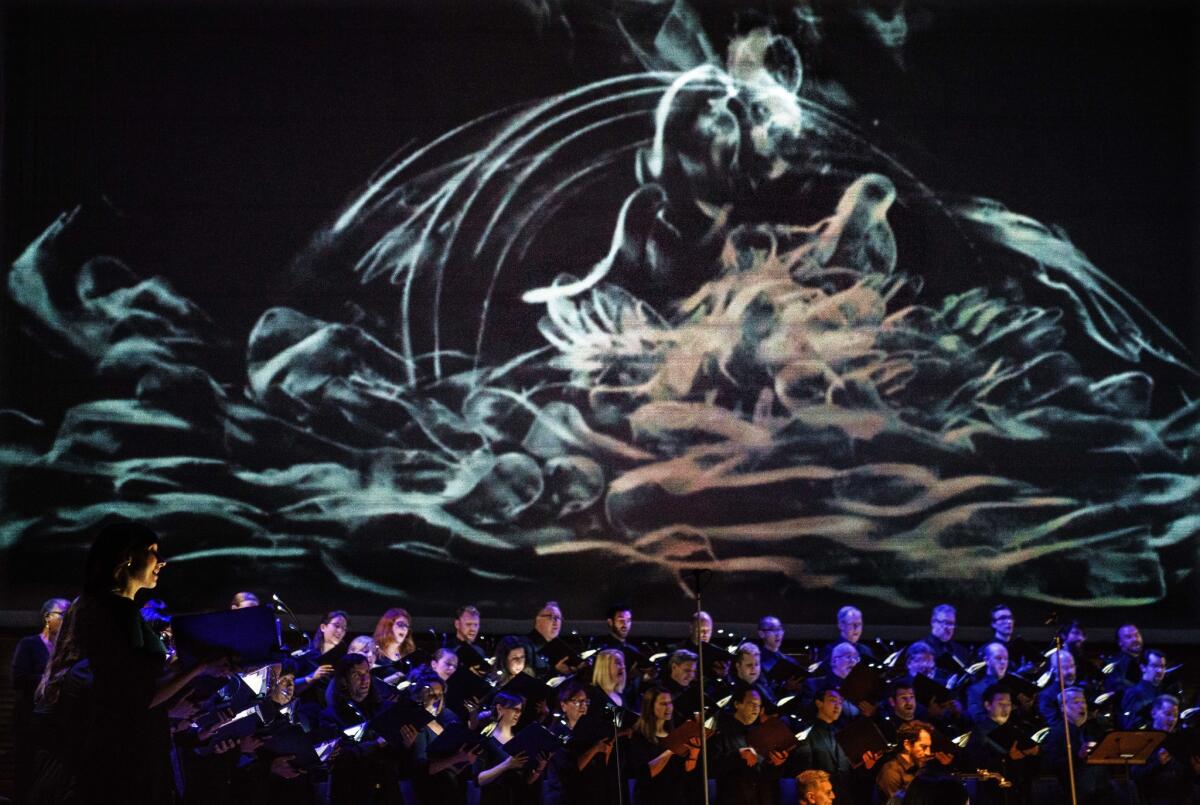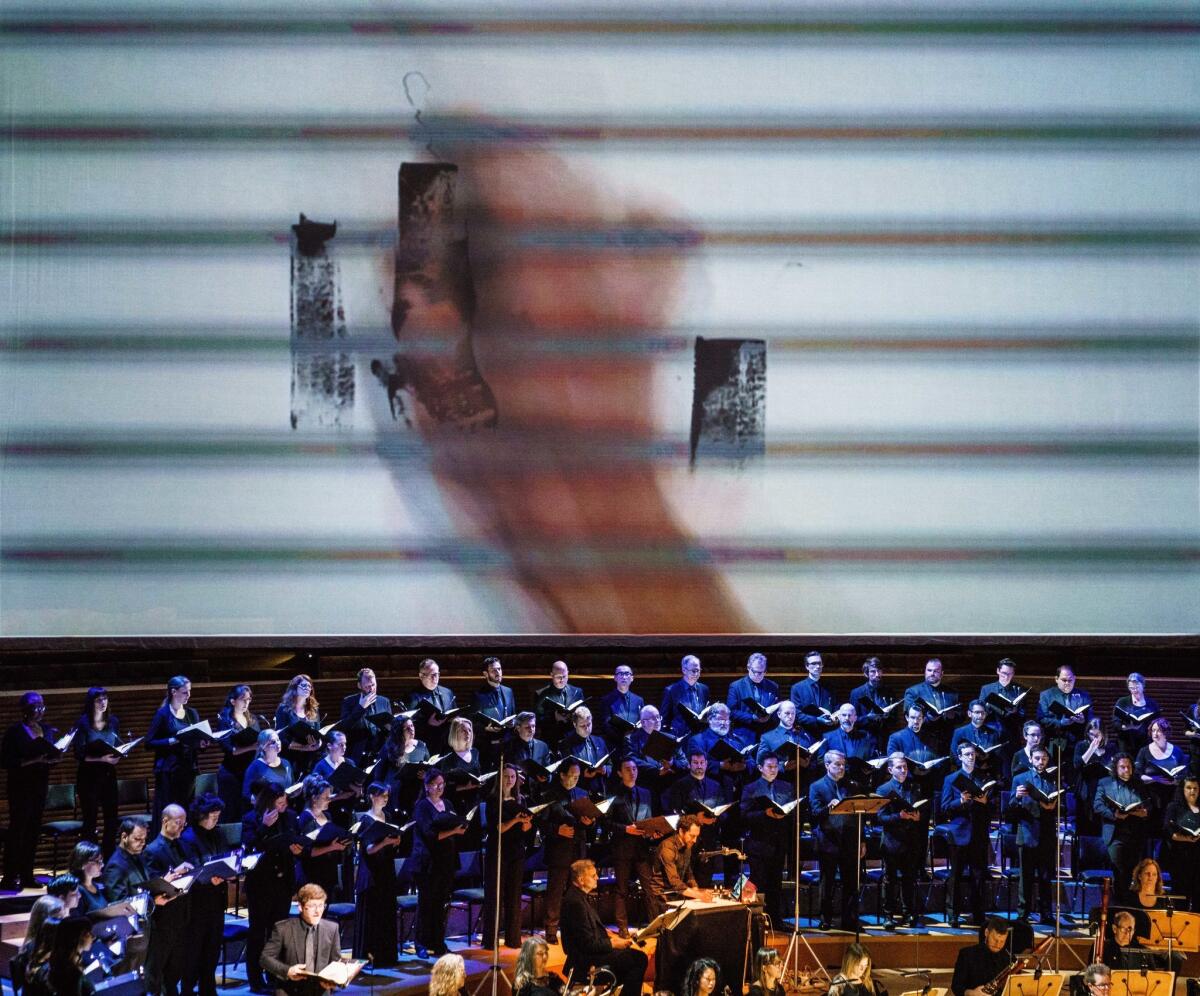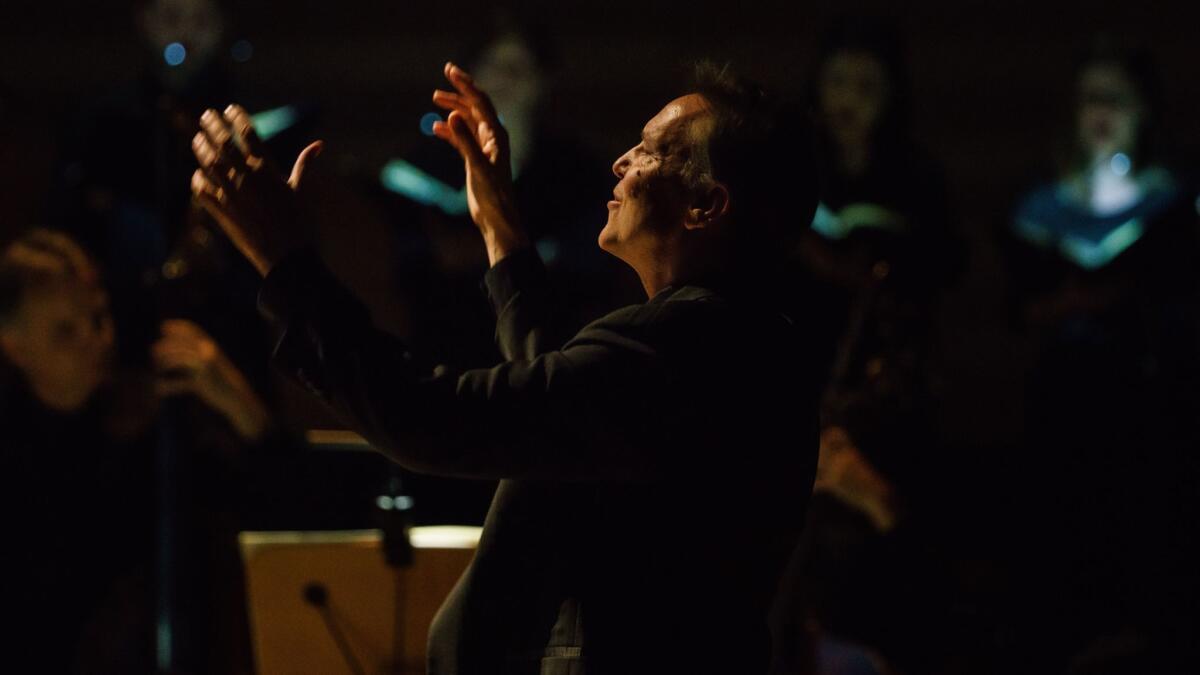Review: Israel and Egypt, then and now, as filtered through Handel and the Master Chorale

- Share via
Handel could have called it “Exodus: Gods and Kings.” His oratorio reflects the biblical account of the heroic flight of Israelites enslaved in Pharaonic Egypt and their crossing the Red Sea, just as Ridley Scott’s 2014 epic movie does.
The composer also could have called it “Passover.” The oratorio is less a narrative of the events (although there is that) than, like the annual ritualistic Jewish holiday, a praise to God for overthrowing slavery, a caution that we never take the gift of freedom for granted.
But Handel called it “Israel in Egypt,” and Grant Gershon conducted a magnificent performance of it Sunday with his Los Angeles Master Chorale that included a live video interpretation by the Syrian Armenian visual artist Kevork Mourad.

Almost exclusively choral and with no specific characters, the oratorio is the voice of an exiled people. The very title, which you would be excused to mistake for a current newspaper headline about Israeli air strikes on ISIS in Egypt, is a prompt that the diaspora, two millenniums later, remains a crisis seemingly never to be resolved.
In a talk before the concert, Mourad spoke about how personal the project felt to him, a Syrian of Armenia descent. A century ago, exiled Armenians fled to Syria. Now, of course, civil war has resulted in millions of newly exiled Syrians.
A computer artist, Mourad placed himself with his equipment between the orchestra and chorus in Walt Disney Concert Hall. He provided animated drawings illustrating the text, some created live, on a giant screen covering the hall’s organ pipes.
Mourad further explained that one of the main forms of artistic expression in Syria, as in much of the Middle East, is storytelling. Nights are spent in cafes hearing tales imaginatively and hypnotically spun. That is what he attempted on the video.
Some of the imagery, mostly in what came across as a computerized charcoal drawing, was pre-composed video, but for several numbers Mourad produced the images live, reacting to the music he was hearing. You could see his shadowy hand and arm at work.

Abstract images regularly generated something specific relating to ancient Egypt — jumbled collections of temples or exiles, the shape of the sea, Jews escaping with large Torah backpacks, the destruction of war. Most of this was literal, with little attempt, other than stylistically, by Mourad to relate his work to the present.
The drawings were often interesting, and one could easily imagine an exhibit of Mourad’s responses to Handel. Video-wise, now and then an enthralling projection illuminated the stage. But as video theater, this was more about Mourad’s own processes. The final result gave the impression of spending 2 1/2 hours in the artist’s studio watching him work as “Israel and Egypt” played over his stereo in the background.
The music, though, played in the foreground Sunday and had tremendous cultural significance. Gershon chose to present the original three-part version of the oratorio, which has become the completest fashion in the past couple of decades. After early performances Handel cut the opening section, a gloomy long lamentation by the Israelites on the death of Joseph, which reused music he had written for a funeral anthem he knew would never be heard again and which he didn’t want to go to waste.
It failed to set the scene for “The Exodus,” and Handel rightly cut it. “The Exodus” jumps right in with plagues. Handel here is at his most wonderfully inventive — oh, those hopping frogs. But what is most remarkable is that the descriptions are all from the voices of the people. These are not descriptions of events but reactions to them. When God leads the people forth like sheep, the chorus sings with the idyllic sweetness of, well, sheep.
Every chorus is different. There are moments that might remind you of “Messiah,” which is a kind of sister oratorio, the only other of Handel’s works based exclusively on biblical texts. There are grand double-chorus fugues. The orchestra includes three trombones. The heavens can, like the Red Sea, part. But the choruses of intimacy are just as impressive.
The final and longest part is “Moses’ Song,” but there is no Moses to sing it. Even his song is filtered through the voice of the people. This is how they hear Moses. They rejoice as you might expect in the miracles of nature, the parting of the Red Sea and the flood of the mighty waters that swallow the pharaoh’s chiefs, chariots and horses.
In a duet early on between two solo basses, “The Lord is a man of war,” Handel’s music is oppressively cheerful. The basses (David Dong-Geun Kim and Chung Uk Lee) exult in mission given divine blessing. Neither Mourad nor lighting designer Azra King-Abadi would have any of it. The stage was bathed in red light. Mourad made clear that this is death sugarcoated. Gershon underscored a grimness that isn’t obvious in the music.

This profoundly colored the great celebration of God that followed, reminding us that this really isn’t Moses speaking but the people intoxicated by victory, a people who would turn against Moses and his Ten Commandments. As a study of the complexity of crowds and power, the performance — video or no video — took the breath away. Exile, Handel reminds us as our political discourse does not, is no single, black-and-white thing.
Can one say enough about Gershon’s Master Chorale? Last week it was sensational in Leonard Bernstein’s “Mass” with the Los Angeles Philharmonic. Here it channeled much of Bernstein’s war-weary sentiment in an “Israel in Egypt” as much for our time as is “Mass.”
Handel gives the soloists, here drawn from the chorus, little work. But tenor Jon Lee Keenan got a moment to dazzle in “The enemy said, I will pursue.” Just before the final, celebratory chorus, the angelic purity of soprano Elissa Johnston’s “And Miriam the prophetess,” rained down from a high balcony above the stage, the voice of hope, hearable but as yet unreachable, that is Handel’s still meaningful message for Israel and for Egypt and their neighbors.
More to Read
The biggest entertainment stories
Get our big stories about Hollywood, film, television, music, arts, culture and more right in your inbox as soon as they publish.
You may occasionally receive promotional content from the Los Angeles Times.











